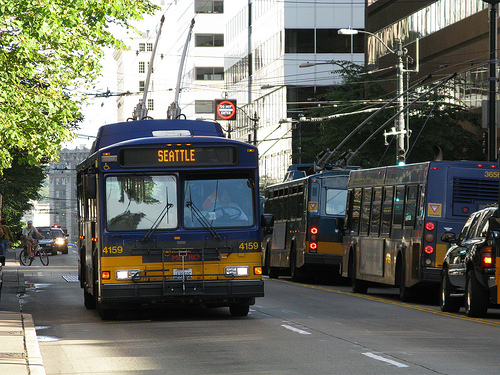The poverty-public transit connection
Seattle, which last year upped its minimum hourly wage to $15, just launched an innovative concept in public transit: income-based fares for its impoverished population. While fare hikes always make the news, Seattle’s King County Metro and Sound Transit has begun offering transit riders income-based discounts, which can drop fares by more than 50%. As Forbes reports, the city’s transit fares rose by 25 cents on March 1, just as the city’s transit agency announced a program that would reduce fares for those riders earning 200% or less than the federal poverty line.

Image from Oran Viriyincy.
That program, called the ORCA Lift Reduced Fare Program, sets a max income of $23,340 for individuals and $47,700 for a four-person family. (As Forbes points out, the agency’s math appears to be off — the Department of Health & Human Services stipulates a $11,700 income for individuals and $24,240 for a family of four.) But aside from the faulty calculations, the program will save qualified riders up to 50% or more on the city’s light rail, buses, water taxis and streetcars. It will cost the city about $7 to $9 million, and the city says it is the second American city (following San Francisco) to offer income-based fares. Rides will cost those who qualify $1.50 each, which is less than half the usual price.
Many of the city’s commuters from the suburbs, who are too poor to afford living closer to their jobs near the city center, can scarcely afford to get to work. “I would characterize this as a safety valve,” Dow Constantine, King County executive and chairman of Sound Transit, a transportation agency, tells the New York Times. Between 1999-2012, 95% of the area’s households were either rich (earning over $125,000 yearly) or poor (earning less than $33,000). The area is comprised of “people doing really well, and people making espresso for people who are doing really well,” explains Constantine.
Almost all of the public transit in America is largely subsidized by the government, points out the New York Times, “no matter how rich or poor the riders are.” Public transit budgets are dealing with “severe stress,” and more than 70% of the nation’s transit systems have cut service and/or raised fares during the recession, and post-recession. Seattle alone raised its public transit fares six times since 2008.
San Francisco’s comparable program, Muni Lifeline, began in 2005 but serves less than 20,000 of its 350,000 daily users. There are also similar but much smaller ventures in Ohio, where social service agencies are distributing vouchers to low-income clients for job-related trips, and in western Pennsylvania, where a nonprofit has provided transportation service to the area’s poor. Seattle’s program is different: the city has more than double San Francisco’s population, and it is enrolling eligible riders via health clinics, food banks, community colleges and other sites that have served to register people for Affordable Care Act benefits.
Yet critics say that the program doesn’t address the root cause of poverty, but merely facilitates ways for the poor to continue working low-paying jobs in a wealthy city. “Parts of the nation are becoming bifurcated societies, with master and servant classes,” writes Forbes columnist Erik Sherman. “The divide grows and the answer is to provide benefits to help offset some of the crushing expense of living with a low income.” Yet aid, he says, arrives “in the form of bandage strips to slow some of the economic bleeding, rather than changing the greater financial dynamics so people could afford to live and to travel to work without needing assistance.”
But other major cities are looking to Seattle’s program for potential answers to at least one problem — unaffordable transit — that plagues their poor populations. “What Seattle has done is what others might consider,” Art Guzzetti, vice president for policy at the American Public Transportation Association, tells the Times. “Everyone is watching.”
Related Posts
Category: Transportation

















